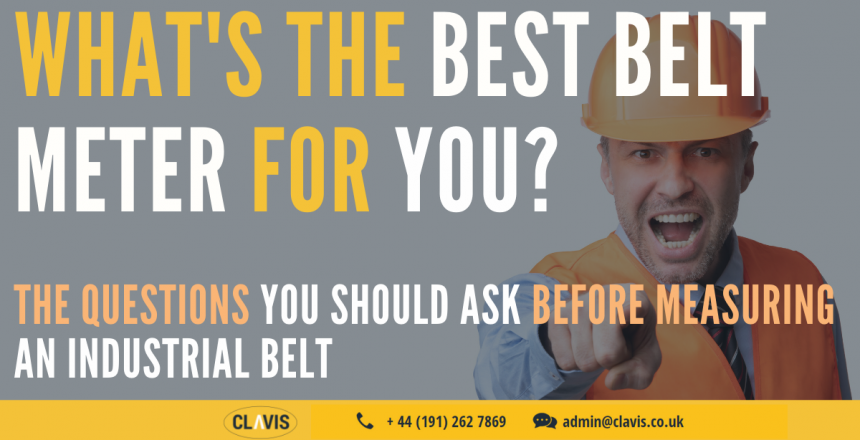Whatever your application — automotive steering systems, agricultural equipment, HVAC systems, 3D printers or any other — the same problems can arise with industrial belts, from improper tension like wear, shortened belt lifetimes, and unexpected maintenance and downtime if the belt fails. Belt tension is vital to your bottom line, so the efficiency, power and lifetime of the belt should come first. But which is the right belt meter for you? Here, I’ll help you decide.
A belt meter can be used for all belt tension gauging applications, from automotive and agricultural equipment to HVAC systems and 3D printers. The belt is tapped to induce vibrations at its natural frequency. Based on a microprocessor using digital signal processing, the meter detects the frequency of vibration and displays this on the unit. Ideally, a belt meter should require little operator skill.
But the belt meter must suit your application and environment. Belt sizes vary greatly, too. In 3D printers, the most common belt width and teeth pitch are 6mm and 2mm, respectively, while V-belts used in large industrial machines can be up-to one-and-a-half inches wide with lengths of around 50in. So, which is the best belt meter for your needs? Here are the questions you should ask.
What kind of equipment will my belt meter be used on?
A belt meter has either an optical or acoustic sensor head and your working environment will effect which you choose. Are there a lot of loud voices, music or machinery in the background? Then your best choice might be an acoustic sensor, a two-microphone system where the belt tension meter reads a signal from one microphone while subtracting certain elements from the other. This cancels out background noise to give a more accurate reading; useful in industrial fans, conveyer drives, industrial blowers or quarry equipment like crushers.
“Some specialists recommend calculating belt frequency by the shaft speed (rpm) or belt length. But the belt’s weight shouldn’t be forgotten, as different belt masses-per-meter require different frequency readings.”
A handheld meter like Clavis’s Type 4 is available in optical or acoustic versions, suitable for all belt types including toothed timing belts and Poly V — it was recently used to measure an enormous industrial belt in a chemical plant for one of our customers. The Type 4 measures frequencies from 10 hertz (Hz) to 600Hz, which leads to our next question.
At what frequency do I tension the belt?
Frequency relates directly to tension in the belt, and they increase in line with one another. Some specialists recommend that you calculate the frequency with factors like shaft speed (rpm) or belt length. But the belt’s weight shouldn’t be forgotten, as different belt masses-per-meter require different frequency readings. This is why, to support manufacturers, Clavis has developed an online Belt Calculator. In the example pictured below, a belt weighing 0.1kg/m should be measured in the range of 94.9Hz to 104.9Hz. Try it for yourself!

When measuring a belt’s frequency, the weight of the belt shouldn’t be forgotten.
The sensor head can also detect the belt’s natural frequency of vibration but, ideally, the twin transducers of the sensor head should be positioned in the centre of the belt to do so. Clavis’s standard Type 3 sensor is suitable for belts up to 25mm wide, or there’s our Type 5 with longer jaws suitable for wider belts. Once you know your belt’s frequency, this can help you choose the right meter. Aside from the 10Hz to 600Hz Type 4, Clavis offers the Type 3 belt meter with a low frequency measurement range down to 7Hz up to 300Hz. This meter is useful for wide belts with large spans.
Can I easily access the belt?
To measure belts in harder-to-reach spots — like more compact engine blocks in hybrid or electric vehicles (EVs) — you’d probably be better off choosing an optical sensor. Optical sensors aren’t angle-dependent and can be placed at any part of the belt, including the belt’s edge to give an extra dimension of measurement. They can be held up to 100mm from the belt, with more flexibility and less need to worry about a “perfect world” scenario.
Otherwise, Clavis supplies a range of interchangeable sensing heads with differing dimensions that are available upon request. Long reach sensor heads are recommended for belts up to 150mm wide, or on all belts if positioned correctly. Medium reach can be used on wider Poly V belts up to 75mm. Or, there is Clavis’s Type 10 cylindrical sensor head that needs only to be pointed towards one face of the belt. Again, it’s more flexible but poorer in rejecting high levels of background noise.
Clavis also manufactures sensor heads to customer specifications, based on computer aided designs (CAD) with a turnaround of two weeks. Ideally, we ship a prototype of the new optical sensor head design over to the US, so the customer can drop it into their production set-up and test it out before we deliver the final product.
Does the belt meter work with Industry 4.0?
Today’s manufacturers want to know absolutely everything about their factories perform through data. Fortunately, Clavis’s advanced belt meters come with an RS-232 connector, the standard that is integral to Industry 4.0 and digitalisation in modern production plants. Clavis’s handheld belt meters like the Type 5 and Type 7 are equipped for RS-232. The Type 5 and Type 7 can be modified to communicate wirelessly via Bluetooth.
Each time a measurement of your belt is successful taken, the meter transmits a string of American Standard Code for Information Interchange (ACII) characters through the R-S232 serial port or wirelessly to your plant’s PC or software. Real-time updates on belt performance can be exceptionally useful as part of your maintenance strategy.
We also recommend using the FourierBMS. Rather than being a handheld meter, the Fourier is a wall mounted unit equipped with a programmable logic controller (PLC) and closed-loop system. That means it can operate independently from your setup, and still be relied on for measurements and data capture during plant shutdowns.

